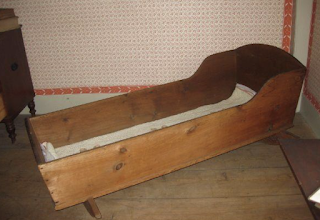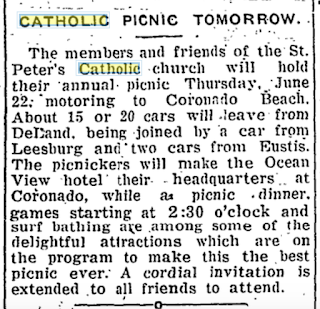 |
Pensacola was hit hard by the 1918 Spanish flu. This
screengrab is from the Oct. 4, 1918 Pensacola Journal. |
The coronavirus pandemic has made me think about the 1918 Spanish flu epidemic. How did Floridians fare during that crisis? I wondered a lot of things - did they hoard supplies, practice social distancing, and argue among themselves about how serious the situation was?
They had no instant means of communication back then. Telephones existed but weren’t yet in every home, particularly in rural areas. Radio wasn’t widespread until the 1920s. Seems to me common people in Florida in 1918 had the telegraph, postal service, and newspapers.
Then, as now, calmness was advised. The Pensacola Journal, on Oct. 12, 1918, told people not to panic. The newspaper explained what to look for when feeling unwell, and offered tips on how to self-treat.
Many symptoms of the Spanish flu sounded familiar to those of COVID-19: chills, aches, sometimes nausea and dizziness, general feeling of weakness, temperature up to 104 degrees that lasted three to five days, a hard cough that grew worse at night, sometimes a sore throat, and often the appearance of a severe head cold.
People were told to go to bed at the first symptoms, both for themselves and to avoid spreading the flu. Then, as now, there was no cure. In 1918, flu victims were advised to take a purgative, eat nourishing food, and take medicine as advised by their doctor.
Home options included taking quinine, aspirin, something called Dover’s Powder, and rubbing the throat, neck, and upper back with Vick’s Vapo-Rub. At that time, it was a relatively new product. The newspaper felt a need to explain that it was a salve whose ingredients included menthol, camphor, and oils of eucalyptus and thyme.
The chief worry was the threat of additional complication in patients with compromised systems because of underlying health conditions. The elderly were particularly susceptible. In general, patients were advised to stay in bed for two more days after their fever subsided. Those over 50 were to stay in bed four extra days. Back in 1918, anyone older than 50 was considered well up in age. Life expectancy in the United States in 1918 was 36.6 years for men and 42.2 years for women, according to a University of California, Berkeley, demographic table.
“Evidence seems to prove this is a germ disease spread principally by human contact …” explained the Oct. 12 Pensacola Journal article. People were told to avoid crowds, common drinking cups and towels, to take plenty of exercise in the open air, and to eat good food. Exactly what we’re being told to do today.
Then, as now, younger people also succumbed. The Daytona Beach News Journal, on Dec. 29, 1918, carried news of the death of a 17-year-old girl who had fought the flu for 10 days. She wasn’t the only young person whose death I noticed while browsing online.
Illness also spread through the armed forces. The country was still fighting World War 1 in 1918. Even after the war ended in November, war news predominated in newspapers as peace commissions met and troops started to return home. The Daytona Beach News Journal, on Dec. 5, 1918, reported a snapshot of how the flu affected men in uniform. Of the 20,500 deaths among troops between Sept. 14 and Nov. 8, an astonishing 19,800 deaths were attributed to the epidemic.
Individual cases around Florida were cause for newspaper updates. The Ocala Evening Star, on Oct. 7, 1918, reported that Doc Lanier in Fort Lauderdale was much improved after a week’s illness “with the fashionable Spanish ‘flue.’ ” Doc was again to be found behind the prescription counter at Beck’s drugstore. Also, a local Ocala man, Mr. L.E. Yonce, a baggage master on the A.C.L. Railway from Jacksonville to Leesburg, was reported to be finally able to get up after being down with the flu at home for several days.
While much flu news was relegated to inside pages - war news took precedence on most days - the Pensacola Journal on Oct 4, 1918 gave top placement to news that all area agencies were cooperating to combat the flu. Representatives of the U.S. Public Health Service, city health department, civilian relief committee, and Red Cross planned a morning press conference that day to combat what had become an epidemic in the city. The Red Cross had ordered more civilian aid in Pensacola, in which many industries were said to be handicapped.
“Interference of the disease is beginning to be felt in every quarter of the city,” the article said. Only 18 of a force of 102 were able to report to work at the city’s electric company. Elevators and telephone service were disrupted by illness of the operators. People were urged not to use the telephone unless absolutely necessary. The Naval Air Station was sending six pharmacists to local drugstores to help get out medicine to the sick.
Just like today, gatherings were canceled. A War Camp Community Sing was canceled, as were the Naval Air Station’s weekly dances. Churches canceled services, and lodges and guilds halted meetings.
Of depressing note: what I always knew as the “1918 Spanish flu” started earlier and ended later. On Dec. 1, 1918, the Daytona Beach Morning Journal reported that experts from the United States, Canada, and South America would meet in Daytona Beach the following week for the American Public Health Association’s annual convention. At that time, the experts were to coordinate plans for battling the flu epidemic in 1919. Another wave of illness was expected to sweep the country in 1919. Dr. W. A. Evans, former health commissioner of Chicago, was quoted as saying the Spanish flu first made its appearance in Spain in 1913. He also noted that, by 1918, Spain was already having its second outbreak.
We’re only weeks into high-alert mode here in Florida as coronavirus cases continue to climb. Stay safe, all.
















